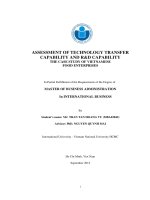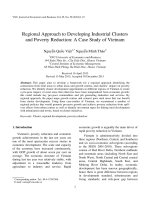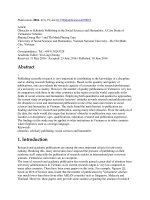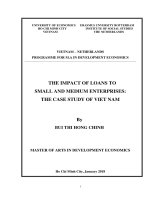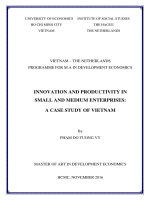Innovation and productivity in small and medium enterprises a case study of vietnam
Bạn đang xem bản rút gọn của tài liệu. Xem và tải ngay bản đầy đủ của tài liệu tại đây (549.5 KB, 102 trang )
UNIVERSITY OF ECONOMICS
INSTITUTE OF SOCIAL STUDIES
HO CHI MINH CITY
THE HAGUE
VIETNAM
THE NETHERLANDS
VIETNAM – THE NETHERLANDS
PROGRAMME FOR M.A IN DEVELOPMENT
ECONOMICS
INNOVATION AND PRODUCTIVITY IN
SMALL AND MEDIUM ENTERPRISES:
A CASE STUDY OF VIETNAM
By
PHAM DO TUONG VY
MASTER OF ART IN DEVELOPMENT ECONOMICS
HCMC, NOVEMBER 2016
University of Economics
International Institute of Social Study
Ho Chi Minh City
The Hague
Vietnam
The Netherlands
VIETNAM – THE NETHERLANDS
PROGRAMME FOR M.A IN DEVELOPMENT ECONOMICS
INNOVATION AND PRODUCTIVITY IN
SMALL AND MEDIUM ENTERPRISES:
A CASE STUDY OF VIETNAM
by Pham Do Tuong Vy
A Thesis Submitted in Partial Fulfilment of the Requirements for
the Degree of
Master of Art in
Development Economics
Academic Supervisor: Dr. Vo Hong Duc
DECLARATION
I hereby declare that this thesis entitled “Innovation and Productivity in
Small and Medium sized Enterprises: A case study of Vietnam”, which is
written and submitted by me in accordance with the requirement for the degree of
Master of Art in Development Economics to the Vietnam – The Netherlands
Programme. This is my original work and all sources of knowledge carried in this
thesis have been duly acknowledged.
HCMC, November 2016
PHẠM ĐỖ TƯỜNG VY
ACKNOWLEDGEMENT
I would like to take this opportunity to express my deepest gratitude for the
help, support and encouragement of the following people, who have contributed to
the completion of this thesis in their very own ways.
Above all, I would like to express my immeasurable appreciation to my
supervisor – Dr. Võ Hồng Đức for his precious time, support and advices to make
this thesis completed.
Furthermore, I would like to send my great thanks to all the lecturers and
staffs at the Vietnam – The Netherlands Programme for their knowledge and
supports during my time joining in the program. In specific, I am extremely
grateful to Dr. Phạm Khánh Nam and Dr. Trương Đăng Thụy for their valuable
guidance and support in the courses and thesis writing process.
To all of my friends in Class 21 and my colleagues at TPF, I could never
thankful enough for your encouragement and support until the very end of this
thesis.
Last but not least, my deepest thanks and love to my parents, who have
always been beside me. Without their unconditional love, none of this would
have been possible.
ABBREVIATION
2SLS
Two Stage Least Squares.
CDM
Crépon, Duguet and Mairesse.
FE
Fixed Effect.
GMM
Generalized Method of Moments.
GSO
General Statistic Office.
IV
Instrument Variables.
LP
Levinsohn and Petrin.
OLS
Ordinary Least Squares.
OP
Olley and Parker.
R&D
Research and Development.
SMEs
Small and Medium-sized Enterprises.
TFP
Total Factor Productivity.
ABSTRACT
The majority of enterprises in Vietnam is categorized as small and medium
sized (SMEs) firms which play an important role to the sustainable growth of the
Vietnamese economy. As such, improving the productivity of the SMEs is
essentially needed and this request becomes a crucial mission for the governments.
It is generally accepted that innovation and technology improvement are key
drivers of productivity (Bartelsman & Doms, 2000). However, they have not been
well-acknowledged by the SMEs in Vietnam even though their huge contribution
to firm’s productivity is unarguable.
This study aims to examine the relationship between innovation and
productivity in the Small and Medium-sized Enterprises (SMEs) in Vietnam. To
establish and quantify this relationship, this study employs the two-stage process: (i)
the estimation of total factor productivity for each firm; and (ii) a determination of
an innovation – productivity relationship. In the first stage, total factor
productivity is estimated based on production function using the input and output
approach. However, firms might adjust their input level according to expected
productivity shock. As such, a potential endogeneity caused by possible
relationship between input
decision and productivity shocks (unobserved
productivity shock) might exist. To deal with this problem of endogeneity, an
approach developed by Levinsohn and Petrin is applied to estimate firm’s total
productivity. In the second stage, the system- GMM approach is adopted to
examine the relationship between innovation and productivity.
An unbalanced panel dataset from five Small and Medium-sized Enterprises
surveys from 2005 to 2013 is used in this study. Findings from this study indicate
that, in the context of Vietnam, when innovation is measured as innovation
expenditure intensity and high-quality labor share in total firm’s labor force,
innovation activities provide positive and significant impact on firm’s productivity.
In addition, past value of firm’s productivity also has significant relationship with
its current level. This finding implies that higher (lower) level of current
productivity
could lead to higher (lower) level of productivity in the future. The study also
provides empirical evidence to confirm that larger firms might perform better than
the relatively smaller firms. In contrast, capital structure provides negative impact
on firm’s productivity. However, this study fails to provide any evidence to support
the view that longevity of firm does provide significant impact on productivity of
firms.
Key words:
Vietnam SMEs; Total factor productivity; Productivity Shock;
Innovation, GMM.
TABLE OF CONTENTS
CHAPTER 1............................................................................................................ 1
INTRODUCTION................................................................................................... 1
1.1.
Problem statement........................................................................................ 1
1.2.
Research objectives...................................................................................... 2
1.3.
Research questions....................................................................................... 2
1.4.
Research motivations................................................................................... 2
1.5.
Research scope and data............................................................................... 3
1.6.
The structure of this study............................................................................ 3
CHAPTER 2............................................................................................................ 5
LITERATURE REVIEW....................................................................................... 5
2.1.
Schumpeter Theory of Innovation – How does Innovation play its role in
economic development?......................................................................................... 5
2.2.
Productivity: concept and measurements............................................................... 7
2.3.
2.4.
2.1.1.
Concept................................................................................................. 7
2.1.2.
Measurements........................................................................................ 7
2.1.3.
General productivity determinants....................................................... 12
Innovation: concept and measurements................................................................ 16
2.1.4.
Concept............................................................................................... 16
2.1.5.
Measurements...................................................................................... 17
How has the relationship between innovation and firms’ performance been
analysed in the literature?..................................................................................... 18
CHAPTER 3.......................................................................................................... 23
RESEARCH METHODOLOGY......................................................................... 23
3.1.
An overview of Vietnamese Small and Medium-sized Enterprises............23
3.1.1.
Statistic overview................................................................................ 23
3.1.2.
Difficulties........................................................................................... 26
3.2.
Methodology.............................................................................................. 27
3.1.3.
Conceptual framework........................................................................ 27
3.1.4.
Model identification............................................................................. 29
3.3.
Research hypotheses and concept measurements....................................... 34
3.1.5.
Research hypotheses............................................................................ 34
3.1.6.
Concept and variable measurements.................................................... 34
3.4.
Data sources............................................................................................... 36
CHAPTER 4.......................................................................................................... 39
EMPIRICAL RESULTS....................................................................................... 39
4.1.
Total Factor Productivity of Vietnamese SMEs.......................................... 39
4.1.1.
Data descriptions.............................................................................................. 39
4.1.2.
Total factor productivity from production function estimation of Vietnamese
SMEs 42
4.2.
Innovation – Firm’s productivity relationship............................................ 45
4.1.3.
Data descriptions.............................................................................................. 45
4.1.4.
The relationship between innovation expenditure intensity and firm’s
productivity....................................................................................................... 46
4.1.5.
The relationship between high-quality labor share in total firm’s labor force and
their productivity.............................................................................................. 49
CHAPTER 5.......................................................................................................... 52
CONCLUSION AND POLICY IMPLICATION................................................ 52
5.1.
Conclusion remarks.................................................................................... 52
5.2.
Policy implications..................................................................................... 54
5.3.
Limitation and potential future research..................................................... 54
REFERENCES...................................................................................................... 56
APPENDIX 1: Empirical studies on general productivity determinants..........62
APPENDIX 2: Empirical studies on relationship between innovation and
firm’s performance................................................................................................ 65
APPENDIX 3: Durbin – Wu Hausman test for endogeneity.............................. 69
APPENDIX 4: Durbin – Wu Hausman test for endogeneity............................. 71
LIST OF TABLES AND FIGURES
Table 3.1:
Classification of SMEs in Vietnam
Table 3.2:
Concepts and measurements of variables used in the study
Table 3.3:
Number of observation in selected industries in dataset
Table 3.4:
Number of observation after filtering
Table 3.5:
Number of observation after filtering in stage 2
Table 4.1:
Descriptive statistics of production function
variables
Table 4.2:
Comparison of OLS, Fixed Effect and LP estimators in Foods, Woods
and Rubber and Plastics
Table 4.3:
Comparison of OLS, Fixed Effect and LP estimators in Non-metallic
mineral, Fabricated metal and Furniture
Table 4.4:
Descriptive statistics of TFP and its determinants
Table 4.5:
Regression results of innovation expenditure intensity and firm’s
productivity
Table 4.6:
Regression results of high-quality labor share in total labor force and
firm’s productivity
Figure 3.1:
Number of enterprises at 31/12 (by size of employees)
Figure 3.2:
Conceptual framework
CHAPTER 1
INTRODUCTION
This chapter introduces the research topic and presents research objectives,
research questions and motivation. Research scope and data requirement also are
discussed in this chapter.
1.1.
Problem statement
In line with Decree No. 56/2009/ND-CP regarding assistances for the
development of small and medium – sized enterprises (SMEs) in Vietnam, the
SMEs defined as firms with total employee between 10 and 300, and total equity
less than 100 billion dong. Following these criterion, up to Mar 2015, total SMEs in
Vietnam account for over 90% of all enterprises. These firms have created more
than half a billion of jobs every year. These firms also contribute appropriately
40% overall GDP.
SMEs play an important role to the sustainable growth of the economy.
Improving the productivity of SMEs is essentially and urgently needed and this
need becomes a crucial mission of the Vietnamese Government because the growth
of the economy depends significantly on the productivity of firms in the
economy. Key drivers of firm’s productivity are innovation and technology
improvement (Bartelsman & Doms, 2000). However SMEs in Vietnam have still
struggled in their operations and therefore lead to inefficiency. One of the
obstacles facing SMEs in Vietnam is the process of acknowledging the important
role of creating innovation and applying new technology in production to increase
their productivity. Innovation has not attracted great attention from the SMEs
themselves even though huge contribution to firms’ productivity is widely
confirmed.
The common measurement for innovation in empirical studies is R&D
expenditure of a particular firm. Various empirical studies have been conducted to
quantify the relationship between R&D expenditure and firm’s performance.
1
Conclusions vary from these studies including strong correlation between the two
(Siedschlag, Zhang and Cahill (2010); Belderbos, Carree and Lokshin (2004);
Crespi and Pianta (2009)). However, in the Vietnamese context, small and
medium-sized firms have not widely reported their spending on research and
development activities. In addition, innovation activities of SMEs is less formal
and involved in many different exercises as compared with larger firms. As such,
research on the impact of innovation on SMEs productivity faces many obstacles in
the Vietnamese context.
A lack of interest in relation to the relationship between innovation and SMEs
productivity in Vietnam has opened up the interest of deep investigation. It is
especially essential in the context of the economy dominated by SMEs and
technology level is still low. Therefore gaining further knowledge in this field is
needed for policy makers to orient the development creation and application of
innovative activities toward the growth of firms as well as country.
1.2.
Research objectives
This study is conducted to provide an additional evidence on the relationship
between innovation and firms’ productivity for the Vietnamese SMEs. The main
objective of this study can be summarized as Defining and quantifying the
relationship between innovation and productivity in firm level in the context of
Vietnamese SMEs.
1.3.
Research questions
The study aims to provide empirical evidence for the main questions emerged:
Is there any relationship between innovation and productivity in the context of
SMEs in Vietnam? If yes, then how does innovation can affect SMEs productivity?
1.4.
Research motivations
This study aims to provide the closer look at the Vietnamese SMEs’
productivity using the approach of Levinsohn and Petrin (2003), how it could be
changed due to changes in the level of innovation making. Despite the fact that
innovation play a crucial role in the development, the outcome of innovation
1
2
activities are uncertainty. We do not know beforehand whether these activities
would success
1
3
in creating value added to the firms. Research results provide policy makers some
evidences on how to appropriately allocate the available resources to obtain the
target productivity. This topic is interesting in the context of developing countries
such as Vietnam for two reasons as suggested by Indjikian and Siegel (2005).
Firstly the benefit of innovation might not be fully exploited in developing
countries. Secondly, in these countries, national resources allocated to creating
new innovation still are restricted despite the fact that innovation plays an
important role in global growth.
1.5.
Research scope and data
The study aims to determine the relationship between innovation and
productivity in Vietnam SMEs from 2005 to 2013 in six selected industries include:
(1) foods; (2) wood and wood-related products; (3) rubber and plastic products; (4)
non-metallic mineral products; (5) fabricated metal products and (6) furniture. The
reason why these six insuctries are selected in the study is that data of these
industries is biggest and have accounted for nearly 70% of total SMEs in the fiveround survey, therefore can be representative for the whole dataset. At the time
data used in this study was collected, the dataset of 2015 survey was not fully
gathered and published. As such, data used in this study only ends in 2013.
1.6.
The structure of this study
This study contains five chapters which can be presented as follow:
Chapter 2 provides theoretical and empirical studies on the relationship
between innovation and productivity. Chapter 2 begins with Schumpeter Theory of
Innovation that explains the role of innovation to economic growth. Then this
chapter reviews the concept of productivity and the methods of how productivity
can be estimated as well as its determinants. In addition, the definition of
innovation and how it is measured are discussed in the chapter. The relationship
between these two concepts has been reviewed through literature.
Chapter 3 presents the methodology which is utilised in the study. An
overview of Vietnam SMEs is discussed. On the ground of literature review in
1
4
Chapter 2, the conceptual framework is constructed. The measurement of relevant
variables and
1
5
regression techniques are described. In addition, this section also includes the
process of how to filter data.
Chapter 4 presents empirical results. Statistical descriptive of data is presented
in this chapter. Then, the findings on Vietnam SMEs’ productivity are described and
discussed. The results of regression in relation to the relationship between
innovation and productivity are presented in this chapter.
Chapter 5 provides the summary of the main results and proposes some policy
implications based on the results described in Chapter 4. This Chapter also includes
research limitation and suggests some further research direction in the future.
CHAPTER 2
LITERATURE REVIEW
This chapter provides the literature review on the relationship between
innovation and productivity. At first, Schumpeter Theory of Innovation that explain
the role of innovation in the economic growth is presented. Then the concept,
calculation and determinant of productivity is reviewed. After that, this chapter
presents the definition and measurement methods of concept innovation. In the end
of the chapter, the relationship between innovation and productivity has been
reviewed through empirical studies in the past.
2.1.
Schumpeter Theory of Innovation – How does Innovation play its
role in economic development?
Schumpeter was seen as a person who built very first basic foundation to the
theory of innovation and economic development. In his famous book The Theory of
Economic Development (published first time in 1912), he has argued that the whole
economy has its own business cycle in which technological innovations play an
important role. When a new technology has been introduced and the economy is
ready to adapt then the economy would alter itself to fully employ the new
technology and resulted in the upward trend of the business cycle. If that new
technology has been introduce at the time the economy is saturated and became
more vulnerable to the any negative shock and easily get into depression then only
new technology might not help out the whole economy. Schumpeter also argued
that firms should willing to take risk and invest in new technologies to take
advantage of the profit at the early stage of these new technological innovations
when the other firms haven’t applied.
Together with The Theory of Economic Development (1934), Capitalism,
Socialism and Democracy (1942) and Business Cycles: A Theoretical, Historical
and Statistical Analysis of a Capitalist Process (1939), Schumpeter has contributed
to the economics theories with the role of innovation and entrepreneurship in the
economic development. He believed that innovation is the core driver of
development as well
as emphasized the role of entrepreneur of smoothing the mechanism in which
revolutionarily technical changes occurs via innovation and push the economy out
of its steady state.
Schumpeter explained the development of the economy is mainly driven by
innovation which he categorized into five types:
(i)
launching new products, whether these are about improving a part of
products or totally new to the market,
(ii) introducing new method of production,
(iii) opening new markets which have not entered in the past yet,
(iv) searching/discovering new sources/suppliers for raw material and other
inputs in production process,
(v)
acquiring new market structures in any industry (i.e. changing the
monopoly position).
How innovation could become driven to the growth of economy? According to
Schumpeter, innovation can be expressed in a process of four steps: invention,
innovation, diffusion and imitation (Schumpeter, 1942) in which the first two steps
have less impact while the last two have much more influence on the economic
growth. His arguments relied on the vague of economic achievements in the early
stage of innovation, after that economies would realize the potential of increasing
sales or cost deduction when they come to the period of diffusion and imitation and
at that time they invest more in these innovation. However purely ideas could not
alone play the whole game, they need a power to implement these ideas. At that
necessarily, entrepreneur play important role of allocating the resources to the
process of replacing old technologies with new ones which Schumpeter labelled as
creative destruction. In other words, Schumpeter explained the economic
development through the process of creative destruction driven by innovations.
2.2.
2.2.1.
Productivity: concept and measurements
Concept
Productivity is the efficiency of the process in which firm, industry and
country convert input factors in to output. Therefore productivity is generally
defined as the ratio between output and inputs in the manufacturing process.
Productivity is a good indicator to economic performance of firm, industry or
country as a whole.
There are two things could affect productivity: through the availability of
input resources and through value adding to the products in producing process. In a
further details, firm’s productivity could be decreased in the circumstances of
lacking inputs or inputs were not used efficiently. However through creating
value added with available inputs and certain activities in manufacturing process
helps to improve productivity.
2.2.2.
Measurements
There are many ways to measure productivity, but they could be classified
into two groups: single factor productivity measures (in which productivity is the
ratio of output over single input) and multifactor productivity/total factor
productivity measures (a measure of output to several inputs).
In the group of single factor productivity, there are two ways to measure
productivity: labor productivity and capital productivity. In both ways, productivity
has been expressed as quantity index of labor input/capital input over an index of
gross output or value added. These measures are easy to calculate but they only
reflect the partial productivity of workers’ capacity or capital intensity, how
efficiency they are in combine with other input factors in production process. To
have a better index of productivity in which take into account contribution of
more than an input, multifactor productivity/total factor productivity turns out to
be more efficient measure. Therefore in this research, total factor productivity has
been used to estimate firms’ productivity.
Estimating total factor productivity through Production function estimators
have been regularly used to address many relevant issues in the literature: the
relationship between foreign direct investment and domestic firms’ productivity
(Javorcik, 2004), impact of R&D (Hall et al., 2009), impact of information
technology (Chun et al. , (2015). These relationships are mostly estimated based on
simple Cobb-Douglas production function regression.
��
�
�
�
�
�
�
� = F(� , � , � ) = �
(1)
�
��
�
Where �� represents firm j’s output, �� is physical capital stock, �� is
labor
input and � � denotes for firm’s level of efficiency, �� and �� are output
elasticities
with respect to capital and labor.
Based on the definition of productivity above, �� is referred to Total Factor
Productivity and could be derived by taking natural logs of (1):
(2)
��� = �0 + �� ��� + �� ��� + ���
Where t subscript denotes time series and lower case letters are represented
for log value. In equation (2), Total Factor Productivity has two components: �0
and ��� , in which �0 is average productivity for all firms across time and ���
captures
firm’s deviation productivity from that average caused by unobserved factors affect
firms’ output outside of inputs. ��� then can be separated in two components:
firmlevel productivity ��� and i.i.d component ��� :
(3)
��� = �0 + �� ��� + �� ��� + ��� + ���
Therefore researchers
can get firm’s productivity from estimating (3) and
solving for ��� :
̂
̂
2
2
(4)
�̂�� = ��� − �� ��� − �� ���
Then, the exponential of �̂�� is the result of firm-level productivity.
Mainly there are two trends of approach of research in how to calculate total
factor productivity, non-parametric and parametric. With non-parametric technique,
growth accounting is the most used based on a paper of Robert Solow in 1957 about
technical changes and production function. Under the assumptions of constant
return to scales and competitive factor markets, growth accounting method
expresses how
2
3
much changes in output growth can be explained by changes in different types of
input and changes in total factor productivity. Although growth accounting
technique is well–established and consistent, it cannot address the problem of
causality, which is investment in technological changes can be driven and
resulted of productivity growth at the same time. With parametric technique,
econometric method has been applied to estimate total factor productivity in the
relationship between production inputs
and
output
(production
function
estimators). There are several benefits by using econometric techniques: the
parameters can be check for the statistical significance; solving problem of
endogeneity.
2.2.2.1.
Growth accounting method
Non - parametric growth accounting method was developed by Robert Solow
in his paper about the technical change through analyzing aggregate production
function (Solow, 1957). Growth accounting approach aims to determine how much
economic growth was due to contribution of inputs (growing by the movement
along the production function) and how much growth was due to the
improvement in technology (shift the production function) (Nelson, 1973). This
approach has the assumption of constant return to scales, which means total
elasticities of all input
factors in production function equal one (from the equation (1), �� + �� =
1).
Typically these input factors are weighted by their income shares (in case of
calculating productivity at country level) (Cardona et al., 2013), or by their cost
shares (when calculating firm’s productivity).
Productivity is calculated by solving equation (4) without econometric sense.
�̂�� is called “Solow residual”, has positive value whenever the growth rate of
output rises faster than the growth rate of input factors. “Solow residual” not only
reflects
growth by changes in technological progress but also other factors that affect the
efficiency in general outside of input factors (Schreyer, 2001)
2.2.2.2.
Production function estimator methods
As mentioned above, there could exist problem of endogeneity caused by
possible relationship between input decision and productivity shocks (unobserved

